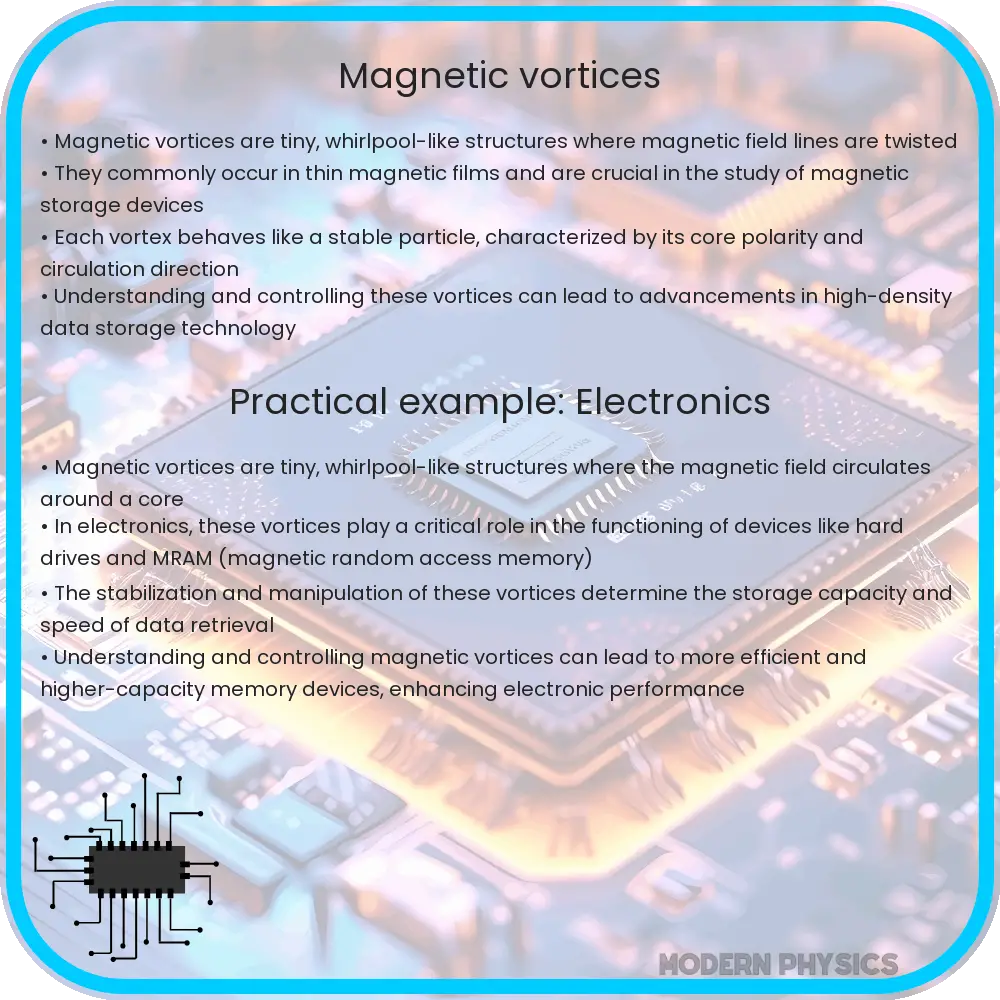Explore the intriguing world of magnetic vortices, their stability, applications in technology and research, and theoretical background.

Magnetic Vortices: Understanding Their Stability, Applications, and Theoretical Background
Magnetic vortices, intricate phenomena in the realm of physics, are characterized by a swirling pattern of magnetic moments. These vortices arise when the magnetic moments of atoms in a ferromagnetic or superconducting material align in a vortex-like structure. This intriguing arrangement of magnetic moments leads to unique properties that have significant implications in various technological and scientific fields.
Stability of Magnetic Vortices
The stability of magnetic vortices is a crucial aspect that determines their practical applications. These vortices are typically stable under certain conditions, influenced by factors like the material’s thickness, composition, and external magnetic fields. For instance, in thin films of ferromagnetic materials, the vortex structure can be stable and persist even in the absence of an external magnetic field. Theoretical models, such as the micromagnetic theory, provide insights into the stability conditions and dynamics of these vortices.
Applications in Technology
Magnetic vortices have found applications in various technological fields. One significant area is data storage. The unique properties of magnetic vortices, especially their stability and size, make them suitable for high-density magnetic storage devices. In such devices, each vortex can represent a single bit of data, allowing for a compact and efficient storage solution.
Another application is in the field of spintronics, where the electronic spin of particles is exploited to develop advanced electronic devices. Magnetic vortices can be used to create spintronic devices with enhanced performance, such as spin valves and magnetic tunnel junctions.
Theoretical Background
The theoretical understanding of magnetic vortices is grounded in quantum mechanics and condensed matter physics. The behavior of these vortices can be described using complex mathematical models that take into account the interactions between magnetic moments, quantum effects, and thermal fluctuations. Advanced computational tools and simulation techniques are often employed to study these systems, providing deeper insights into their properties and behavior.
Moreover, the interplay between superconductivity and magnetism in certain materials leads to the formation of vortices with both magnetic and superconducting properties. The Ginzburg-Landau theory is commonly used to describe such phenomena, offering a framework to understand the coexistence of superconductivity and magnetism in these systems.
- Stability influenced by material properties and external factors
- Applications in high-density data storage and spintronics
- Theoretical models based on quantum mechanics and condensed matter physics
Advanced Research and Future Prospects
Current research in the field of magnetic vortices is focused on exploring their potential in various cutting-edge applications. One area of interest is the use of magnetic vortices in quantum computing. Due to their small size and stability, these vortices could play a key role in the development of quantum bits (qubits) for quantum information processing. Experiments are underway to manipulate and control these vortices at the quantum level, paving the way for breakthroughs in quantum technology.
Additionally, magnetic vortices are being studied for their potential in enhancing the performance of sensors and actuators. Their sensitivity to external magnetic fields can be harnessed in designing highly precise magnetic field sensors. Similarly, the dynamic behavior of vortices under varying conditions can be utilized in micro-electromechanical systems (MEMS) for more efficient actuators.
Challenges and Limitations
Despite their promising applications, there are challenges in harnessing the full potential of magnetic vortices. One of the primary challenges is controlling and manipulating these vortices at the nanoscale, which requires advanced fabrication and imaging techniques. Additionally, understanding the complex interactions between vortices and other quantum phenomena in different materials remains a significant research area.
Another limitation is the thermal instability of magnetic vortices at higher temperatures, which can affect their applications in certain environments. Ongoing research is focused on finding ways to stabilize these vortices at higher temperatures and in different material compositions.
Conclusion
Magnetic vortices represent a fascinating intersection of physics and technology, offering a glimpse into the complex behaviors of magnetic materials at the micro and nano scale. Their unique properties, such as stability and responsiveness to external magnetic fields, open up a myriad of applications in data storage, spintronics, quantum computing, and sensor technology. While challenges in manipulation and thermal stability persist, continuous advancements in theoretical understanding and experimental techniques are pushing the boundaries of what is possible with these microscopic magnetic whirls. As research progresses, magnetic vortices are poised to play a pivotal role in the next generation of technological innovations.
- Exploration in quantum computing and precision sensors
- Challenges in nanoscale manipulation and thermal stability
- Potential for significant technological advancements
